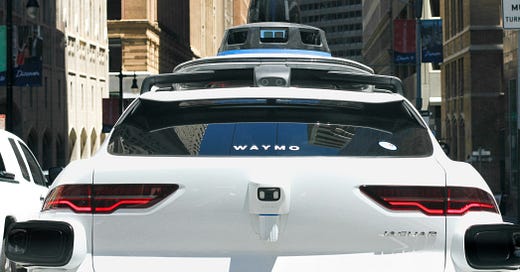People vs. AI takes a destructive, fiery turn
The attack on a Waymo driverless car in San Francisco is understandable frustration overflowing
Welcome to a special edition of The Angle – a response to a breaking news story making waves in the tech world. Paid subscribers can expect to receive these regularly on top of the Tuesday in-depth edition (paid member exclusive) and the Friday round-up (free for everyone).
Today merited a special dispatch because a symbolic, messy, extremely human action against one of the most tangible personifications of AI currently available just took place: A crowd of people vandalized and lit on fire a Waymo self-driving vehicle in San Francisco on Saturday.
Waymo, the Alphabet subsidiary and Google self-driving car project, has been operating fully driverless ride-hailing in San Francisco (as well as a handful of other markets) for a while now. The company’s robotaxis will pick you up and drop you off in a defined area within the city in much the same way an Uber driver would – just without the Uber driver.
I’ve been lucky enough to ride around in a bunch of self-driving cars in my time (including one that crashed into another car at speed on the highway) and I’ve been in Waymos a couple of times – including in one just like the vehicle that the crowd in San Francisco just destroyed. I’ve also ridden in a Cruise car – you know, the GM subsidiary that tried to cover up the fact one of its vehicles ran over and dragged a pedestrian on SF streets after they were first hit by a human-driven car.
As a former reporter who spent a few years at the height of self-driving hype on the front lines of the beat, talking to tech leaders, safety regulators, concerned social organizations and more, I definitely have feelings about autonomous cars, and about their impact and use. Somewhat recently, I posted what remains a solid summary of my thoughts on my matter – well before Cruise’s implosion and Waymo’s recent troubles.
These latest foibles has proven my basic point right: Self-driving cars at scale are not immediately on the horizon. The Cruise incident, the recent Waymo bike accident, and this outright display of hostility all prove that. No matter the track record, which flacks on the other side of this and well-meaning autonomy advocates will no doubt point out still has self-driving tech at well (like, astronomically) lower than the counts of human driver-related accidents and deaths.
On the other hand, I’ve actually really enjoyed my first-hand experiences specifically with Waymo. Taking a ride in one of their vehicles this past fall in San Francisco felt like it ‘just worked,’ without a lot of the weird hiccups and decidedly inhuman behavior when it came to the smoothness and quality of the pickup, ride and drop-off. It felt like the future realized.
Still, I think what happened Saturday proves that even if the technology is at or approaching where it needs to be for large-scale deployment, the social acceptance piece lags far, far behind. Yes, San Francisco is probably a cartoonish, exaggerated instance of the tension at play behind technological and AI accelerationists and those who oppose and fear its progress – but a technology being ready for real-world use, and the real world being comfortable with its use are two vastly different and often unconnected things.
Autonomous driving has been at the forefront of the conversation around AI development since long before ChatGPT and large language models took over the discourse. For most people, though, there’s not much distinction between robots that work factory lines, ones that drive you around and supplant the gig economy, and those that can write copy for your website or generate a photorealistic graphic: They’re all potentially better at doing your job than you are.
So while the Waymo AV pyre is probably also about reported annoying behavior of self-driving cars on city streets, as well as safety fears from the pedestrian perspective, a big part of the motivation behind it is almost certainly tied to frustration about a wave of AI-powered societal change that most people feel unable to fathom or even begin to adapt to.
People aren’t smashing their computers and planning guerrilla attacks on data centers, but a car with no one behind the wheel is an easy, and relatively destructible target for acting out when the base fabric of our everyday lives is being reshaped so quickly. Hopefully this is just an isolated incident, fueled by a city in the midst of a long and roiling identity crisis, but regardless it should be a wake-up call to make sure everyone gets to participate in shaping what our collective future looks like.




